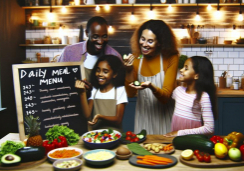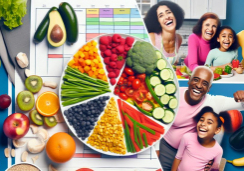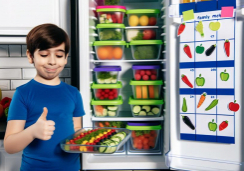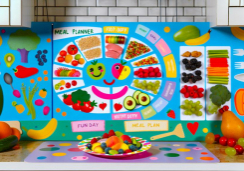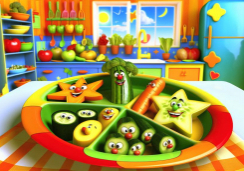What Makes a Protein-Packed Vegan Meal Plan?
Imagine a colorful bowl brimming with quinoa, black beans, and vibrant greens, all contributing to the rich tapestry of a protein-packed vegan meal plan that's as nourishing as it is satisfying.
As you explore the intricacies of such a diet, you'll discover that crafting a menu bursting with plant-based proteins isn't just about replacing meat. It requires a nuanced understanding of where to find those essential amino acids and how to combine them to support your health and fitness goals.
You'll need to consider not only the variety of protein sources but also how they harmonize with other nutrients to create a symphony of balanced meals.
What you might not know yet is how certain preparations can enhance the protein content of your favorite vegan dishes, or how strategic meal timing can optimize your body's use of these vital building blocks.
Stay with me, and you'll uncover the secrets to constructing a vegan meal plan that doesn't skimp on protein.
Essential Protein Sources
Incorporating a variety of plant-based proteins into your diet, such as beans, lentils, tofu, edamame, and spinach, ensures you're getting the essential amino acids your body needs. These vegan protein sources are fundamental to a high-protein vegan meal plan, allowing you to meet your nutritional requirements without animal products.
Beans serve as a staple in a plant-based diet, offering about 15 grams of protein per cup. They're versatile and can be included in numerous dishes.
Lentils are another powerhouse, providing 18 grams of protein per cup. They're excellent in soups and stews or as a meat substitute in many recipes.
High in protein and with a texture that's adaptable to various cuisines, tofu packs in 20 grams of protein per cup, making it a go-to for stir-fries, scrambles, and even desserts.
Edamame, young soybeans often enjoyed as a snack, contains 17 grams of protein per cup. It's a delightful addition to salads and bowls.
Though not as high in protein as other sources, spinach still provides a notable 5 grams of protein per cup when cooked. It's rich in other nutrients and can be easily incorporated into your diet through salads, smoothies, or as a side dish.
Together, these plant-based foods, along with whole grains, contribute to a balanced and protein-rich vegan diet.
Daily Meal Breakdown
Understanding the essential sources of plant-based protein sets the stage for crafting a well-rounded daily meal plan, ensuring you're fueled with the right nutrients from dawn to dusk.
A vegan diet plan high in protein can be both delicious and nutritious, featuring a variety of foods that keep your energy levels steady and your muscles well-nourished.
Starting your day with a High Protein Vegan Meal, like a tofu scramble with spinach, lays a solid foundation.
For lunch, a hearty White Bean and Sweet Potato stew offers a satisfying combination of complex carbs and protein, keeping you full and focused.
Mid-day snacks might include edamame or a blueberry almond chia pudding, both of which are great for a quick protein boost.
Your dinner could be a delectable tofu bowl, brimming with veggies and quinoa, ensuring a high intake of complete proteins.
This meal plan ensures that you're adhering to a well-balanced diet that supports muscle building, weight management, and sustained energy levels.
Efficient Meal Preparation
Regularly dedicating time to meal prep each week can streamline your daily routine, ensuring you're consistently enjoying nutrient-dense, protein-rich vegan meals without the last-minute rush. By using meal prep containers, you can portion out your dishes, making it easier to grab and go.
Here are four key steps to efficient meal preparation:
- Prep a Week's Worth of Meals: Plan your menu with a registered dietitian's insight to include a variety of high-protein plant-based foods. Black beans, lentils, quinoa, and tofu should make frequent appearances on your shopping list.
- Mix and Match Staples: Cook large batches of grains and legumes, and chop veggies ahead of time. This mix-and-match approach allows for diverse meals throughout the week.
- Add a Splash of Creativity: Don't shy away from trying new spices or dressings to keep your taste buds excited. Add a splash of citrus or a new herb to transform a dish.
- Put It All Together: Assemble your meals in containers, strategizing color and texture to make them appealing.
Investing in your meal prep process not only supports your health goals but also offers a sense of accomplishment as you put it all together, ready to enjoy your vegan food whenever hunger strikes.
Vegan Macronutrient Balance
While meal prep sets the stage for convenience, ensuring your vegan meals aren't just protein-rich but also well-balanced in macronutrients is crucial for optimal health. A vegan meal plan should include a variety of plant-based meals that provide a balance of proteins, carbohydrates, and fats.
High-protein foods like kidney beans are a staple in vegan diets, supporting muscle growth and repair with essential amino acids. But remember, macronutrient balance goes beyond just protein. Carbohydrates found in whole grains and legumes fuel your daily activities, while healthy fats from sources like olive oil contribute to nutrient absorption and satiety, which can be beneficial for weight loss.
In your meal prep, aim to combine these macronutrients in each dish. For instance, a breakfast of chia pudding made with coconut yogurt offers a high-protein start with a balance of fats and carbs. This approach not only keeps your energy levels steady but also supports your overall well-being.
Ultimately, a well-rounded vegan meal plan that emphasizes macronutrient balance, while focusing on high-protein plant-based foods, can help you maintain your health and reach your fitness goals without compromising on flavor or variety.
Supplementing Protein Intake
To ensure you're hitting your protein targets, especially if you're an active individual or athlete, consider incorporating plant-based protein supplements such as powders, shakes, or bars into your vegan diet. These can be a convenient way to boost your protein intake and are easy to integrate into your meal plan.
Here are four key points to remember when supplementing protein intake:
- Choose Quality Supplements: Opt for powders or bars made from pea, rice, hemp, or soy protein to ensure you're getting a high-quality source of protein without unnecessary additives.
- Watch for Additives: Look for products with minimal added sugars and artificial ingredients to maintain the health benefits of your vegan meal plan.
- Timing Matters: Incorporate protein supplements throughout the day to keep you satisfied and support muscle repair, particularly after workouts.
- Balance with Whole Foods: While supplements are helpful, strive to get most of your protein from whole foods, using shakes or bars as an adjunct to a well-rounded diet.
Including a small handful of nuts or a cup serving of lentils can complement your high-protein vegan snacks and meals, ensuring you're well-fueled and nourished.
Frequently Asked Questions
What Makes Protein Vegan?
You'll find protein in plant-based sources like legumes, quinoa, and hemp seeds. They offer complete proteins, debunking myths about vegan protein. Nutritional yeast and varied amino acid profiles enhance absorption, despite soy controversies.
What Is Adequate Protein on a Vegan Diet?
You'll meet your daily requirements for protein by choosing a variety of whole foods with a complete amino acid profile, ensuring nutritional balance and optimizing protein absorption for muscle building and health benefits.
How Can a Vegan Get 100g of Protein a Day?
You can hit 100g of protein by incorporating seitan recipes, various tofu varieties, and protein-rich legumes. Add plant-based shakes, sprinkle nutritional yeast, enjoy hemp seeds, snack on edamame, and try spirulina supplements.
How Do Vegans Add Protein to Every Meal?
To add protein to every meal, sprinkle in protein-rich seeds, toss in various legume varieties, explore tofu's versatility, or try seitan options. Utilize nutritional yeast, plant-based powders, and protein-fortified pastas for a boost.
Conclusion
In conclusion, you can achieve your protein needs on a vegan diet by incorporating diverse plant-based sources. Plan your meals around beans, lentils, tofu, and leafy greens to ensure you're getting the full spectrum of amino acids.
Prep your meals in advance to maintain a balanced macronutrient intake throughout the day. Don't forget, supplementing may be necessary to meet specific goals, but always opt for whole foods first.
Stay mindful of your nutrient intake, and you'll support both your health and fitness ambitions.



